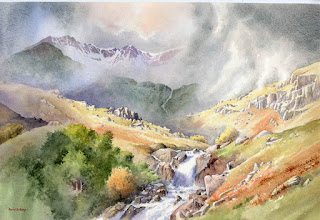I have a great affection for rural lanes, especially old rutted cart-tracks. While they are superb for leading you into a composition they are also excellent subjects in their own right. When I plan a sketching trip I often seek out winding lanes on the walking map, and where they lead to an interesting-looking subject such as a mountain or hill, then there is a strong chance of a good subject.
This particular lane heads towards the Brecon Beacons and I tramped it on a sunny winter day. I particularly liked the way the low sunlight cast shadows across the lane, and was keen to include this aspect, as well as giving the feature a few extra ruts for good measure. Ruts, puddles, clumps of grass and weeds and stones can be exaggerated or even added if they are not present, to give the composition more character. Keep a file of drawings, sketches and photographs of these countryside features so that you can add them in when needed. Undulating hedgerows with gaps here and there enhance the rustic nature of the place as do mature trees and bushes, and if you’re feeling really bold why not include a rustic shepherd wending his weary way home?
The painting was done on a sheet of quarter-imperial Saunders Waterford rough paper, a beautiful surface to work on, and the rough surface enhanced the track, especially where I used drybrush strokes.
It’s been all-action since my last blog, from the marvellous annual festival at Patchings Art Festival in Nottingham’s Robin Hood country where I demonstrated the Saunders Waterford papers for St Cuthberts Mill, and had the pleasure of meeting a lot of you. I’ve also just returned from an immensely rewarding trip to Germany, so that has a lot of potential for some great artwork.
I do hope, like me, you’ve enjoyed this amazing summer and made full use of it with your paintbrush!




